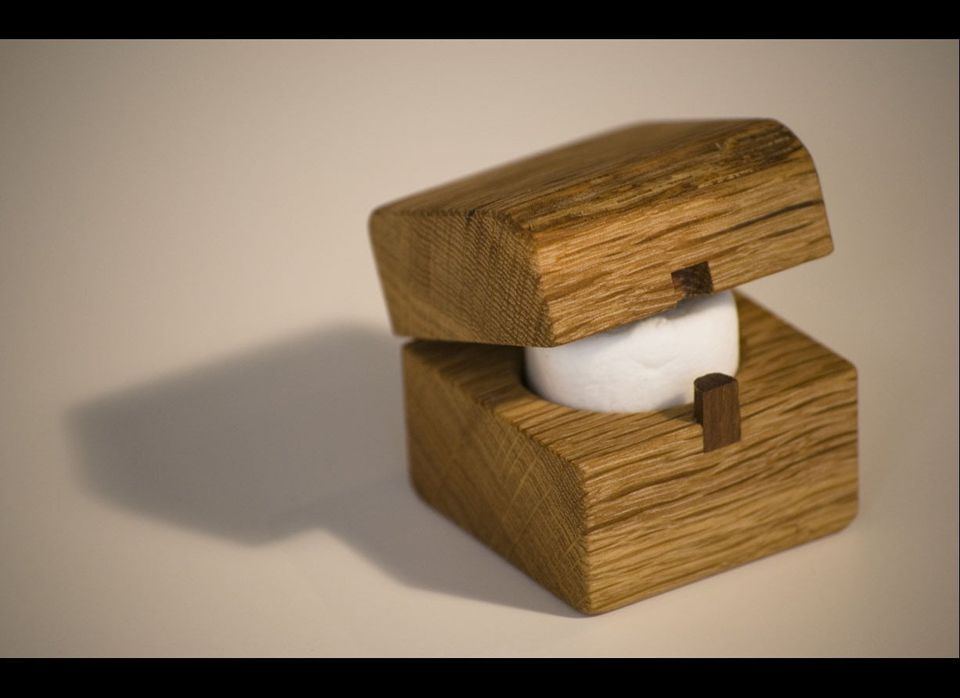Everything about Andrew Riiska's first solo exhibition "Wrong Side Up" is solid.
What elevates furniture making to art, is answered in one solid curatorial move. A table is no longer a table when it's hanging above your head and its carved underside is revealed.
The material Riiska uses is solid. You need chisels and sharp blades to work with wood. What is less well known, is that wood is a mirror, a mirror of truth. Every mark you make is reflected back into the finished piece. There is no tolerance for sloppy craft, none.
If you know where to look, the child like quality that is accepted and celebrated in our cultural pantheon with work's like Calder's Circus is present in Riiska's pieces. I came to this conclusion after studying the smallest piece in the show, a box made to protect marshmallows. The very idea of making a box to protect a marshmallow speaks to a childlike curiosity, imagination and playfulness. When I asked Riiska about this he said "For a brief moment I wanted someone to experience a marshmallow for the first time again". Which of course is the way a child would experience it. When you have an obsession with texture, as Riiska does, the marshmallow makes perfect sense.
The Marshmallow boxes are made from reclaimed oak dunnage. We assume they are squares, but they are not. In plan they are 1-15/16" by 1-7/8" and in elevation there is another intentional increment shift to 1-3/4". The boxes are held together by two wooden pieces of walnut. One can imagine them as teeth that protect the marshmallow. Since there are only two of them, one on the top of the mouth, the other on the bottom they can't bite you when you open it. If you look closely the grain on the box matches, which means the grain on all 160 boxes matches. All the edges, even on the inside, have been sanded, so that like the marshmallow there are no hard surfaces.
Another way to experience this piece is to close your eyes and hold it in your hands. When you do that you can feel the intent the maker reflected back as calmness in the object. The experience of the piece doesn't end there. If you hold it up to your nose it smells flowery. I asked Riiska about this and he told me that he found some oil made from plants that protects the wood and was also food safe. There is no branding mark, nor name as in previous iterations of these boxes, to identify it as made by Andrew Riiska other than its existence.
Once you understand the marshmallow box, all the other pieces in the show can be understood in terms of four shared narratives.
The first narrative deals with the first life of the material as all the pieces are made from reclaimed materials. In other words, materials that have been rescued from the trash. If Riiska isn't intentionally making a political statement with his use of materials, I will. We live in a world with inverted values when society values material at zero that can be redirected from dumpsters and transformed into works of lasting value. According to Riiska, "In a previous life the material has been holding up buildings for close to 100 years. Dry conditions with air flowing around it are the perfect conditions for wood to cure perfectly. If you try to make large flat surfaces without substrates or skirts you will have warping. Using the wood that I use you can avoid this. This isn't something that you can see in the wood rather its something you can feel when you begin to work with it".
The second narrative in Riiksa's work is rebellion from modern methods of production. According to Riiska, "When it comes to building everyone uses the language of the same ruler. I rebel slightly and stay away from that language, the language of the manufactured sheet good, the language of the 4-by-8-foot, the language of the half-inch, the three-quarter inch and one-and-a-half inch -- increments that are common in the world around us."
The third narrative is the artists fantasy of the piece as expressed as an object. This is derived from a working process that does not involve creating drawings that become a pattern for making the piece as in architecture or fashion, or from an iterative design process that moves between drawings and model. Pieces are born from the imagination of the mythical qualities inherent in the material. It is in this narrative that the pieces are named: Dragon Table, Cloud Pony Table , Pollywog Coffee Table , The Old In Out Table, Giant Squid, Bunk Bed Side Table, Spring Back Banker's Chair, 69 Leg Table, Pac-Man Table ,Cactus Coat Rack, Sentinel chairs.
The fourth narrative is construction methods. According to Riiska, "The details that repeat in my work. Exposed joints. Spline construction for jointing boards together to create larger surfaces. Playing with multiple legs. Creating patterns to rebel from. Playing with textures and details that are mostly experienced through touch. Allowing the history of the wood to come through in details like nail holes, wood stitches, and leaving boards close to their original dimensions so you can see it was made from a two-by-four like in my low back chair. Making heavy things seem light. Finding and drawing out the beauty in things that are weathered used and damaged. Adding a little sense of humor and play to design." Riiska is telling us to look a little closer. He is giving us permission to touch. He is telling us that scars tell better stories than tattoos. And he has great stories to tell.
"Wrong Side Up" until April 30, 2012
Jai & Jai Gallery
648 North Spring Street
Los Angeles, CA 90012
818.319.2957
